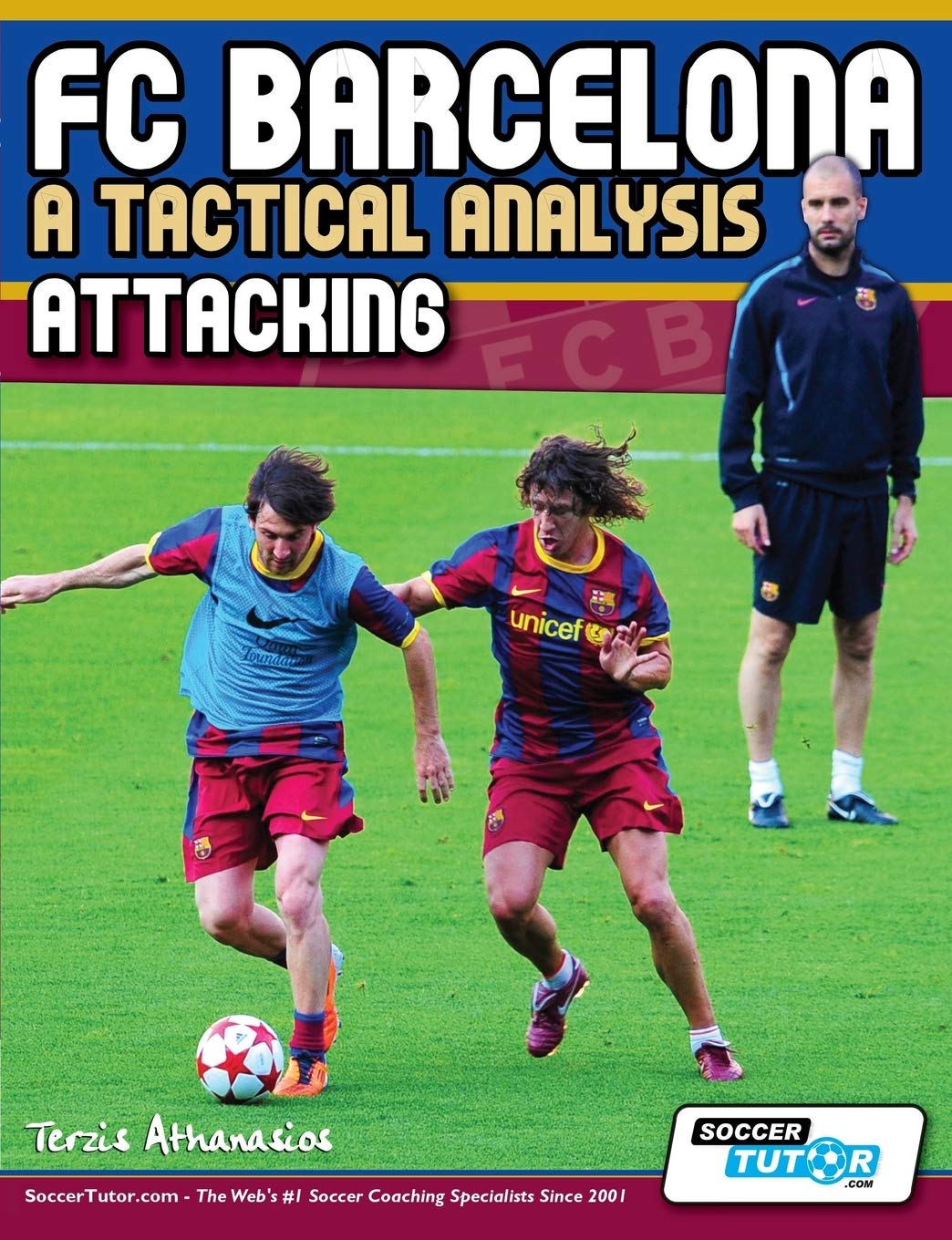CONTENT
CHAPTER 1. THE CHARACTERISTICS OF BARCELONA PLAYERS
1.1. Player Profiles
1.2. Pep Guardiola
1.3. 2010/11 Season 4-3-3 system of play and player positions
CHAPTER 2. THE PHILOSOPHY OF BARCELONA
CHAPTER 3. BARCELONA IN THE FOUR PHASES OF THE GAME
3.1. Barcelona in the defensive phase
3.2. Barcelona in the transition from attack to defence
3.3. Barcelona in the attacking phase
3.4. Barcelona in the transition from defence to attack
CHAPTER 4. BARCELONA IN THE ATTACKING PHASE
4.1. Positioning: Creating the correct shapes
4.2. Movement without the ball
4.3. Diagonal Passing
4.4. Vertical Passing
4.5. Pass and move combinations
CHAPTER 5. BARCELONA,S FORMATION DURING THE ATTACKING PHASE
5.1. Attacking formation
5.2. Attacking formation: Variations
5.3. Playing with 3 defenders
5.4. Creating width
The first stage of the attacking phase
– Building up play from the back
– Vertical pass to the forward
– Messi dropping deep into an attacking midfielder’s position
– Defenders joining the midfield
– Switching Positions
– Defensive Midfielder’s positioning
– Movement into Space
– Rhombus/Diamond shape in the Central Zone
– Forward dropping deep to maintain possession
– Movement: Creating space for others
– Using the correct body shape
– Maintaining possession from wide positions
– Decision making in the final third
– Numerical disadvantage in the final third
– Numerical superiority
CHAPTER 6. THE FIRST STAGE OF THE ATTACKING PHASE AGAINST THE 4-2-3-1 FORMATION
6.1. Attacking down the flank
6.2. Switching play
6.3. Receiving with the correct body shape
6.4. Exploiting Space
6.5. Creating 3 Passing Options
6.6. Receiving with your back to goal
6.7. Body shape determining the next pass
6.8. Approaching the third stage of attack
6.9. Central midfield passing options
6.10. Maintaining balance in the central zone
6.11. Numerical superiority around the ball zone
6.12. Wide Forwards
6.13. Messi dropping deep
6.14. Xavi’s options from his central position
CHAPTER 7. HOW BARCELONA DEAL WITH THE OPPOSITION,S PRESSING DURING THE FIRST STAGE OF THE ATTACKING PHASE
7.1. Vertical passes against the 4-4-2
7.2. Advancing full backs creating space
7.3. Passing out from the goalkeeper
CHAPTER 8. BARCELONA DURING THE SECOND AND THIRD STAGE OF THE ATTACKING PHASE ON THE RIGHT SIDE
8.1. Build up play using a three man defence
8.2. Messi,s wide movement
8.3. Diagonal runs in the final third
8.4. Attacking down the flank
8.5. Attacking down the flank: Overlapping runs
8.6. Combination play near the penalty area
8.7. 2 v 2 Attacking down the flank
8.8. 2 v 1 Attacking down the flank
8.9. Decision making and maintaining possession
8.10. Messi’s driving runs from deep
8.11. Messi maintaining possession
8.12. Messi playing from the right flank
The build up play using a two man defence
– Formations
– Daniel Alves’s passing options
– Messi’s movement into ‘the hole,
– Iniesta advancing into Messi’s position
– Advancing runs from the left back
– Messi in the central zone
– Switching play
CHAPTER 9. BARCELONA DURING THE SECOND AND THE THIRD STAGE OF THE ATTACKING PHASE ON THE LEFT SIDE
9.1. The build up play using the three man defence
9.2. Abidal,s passing options
9.3. Attacking down the left flank; 2 v 1
9.4. Overlapping run
9.5. Passing combinations in the final third
9.6. One-twos and diagonal runs in the final third
9.7. Abidal’s passing combinations
9.8. Inesta’s driving runs
9.9. Movement and the final pass
9.10. 2 v 2 on the left flank
9.11. Maintaining possession in tight areas
9.12. Switching the play to the left flank
The Build up play using a two man defence
– The left back’s passing options
– Passing combinations and awareness on the left side
– 2 v 1 on the left flank
– The left back in an advanced position
– Playing out from the back to create a 2 v 1 situation
– Vertical pass from the back
– Switching from the weak side to the strong side
– Decision making: Entering the third stage of attack
– Switching play from a central position
– Overlapping runs
– Defensive midfielder’s passing options
– Iniesta attacking down the left flank
– Timing runs in behind the defence
– Passing through the midfield line
– Switching play from left to right
CHAPTER 10. THE RETAINING OF BALANCE DURING THE ATTACKING PHASE
10.1. Attacking phase formations; 2-5-3
10.2. Attacking phase formations; 3-4-3
10.3. Defensive midfielder’s role
10.4. The full back’s role
10.5. Maintaining balance; Forwards
10.6. Maintaining balance; Left side
CHAPTER 11. THE TRANSITION FROM ATTACK TO DEFENCE
11.1. The safety player
11.2. Applying immediate pressure when possession is lost
11.3. Busquets as the safety player
11.4. Using three men at the back
11.5. Possession lost near the opposing penalty area
11.6. Winning the ball back in the central zone
11.7. Regaining possession near the sideline
11.8. Regaining possession near to the opponent’s penalty area
11.9. Cohesion in the transition phase
11.10. When immediate regaining of possession is not possible
11.11. When immediate regaining of possession is possible
11.12. Regaining possession in the centre of the field
11.13. Team cohesion to regain possession
11.14. Winning the ball in an advanced wide position
11.15. The opposition win the ball near the halfway line
11.16. Preventing the switch of play
11.17. Using two safety players
CHAPTER 12. THE TRANSITION FROM DEFENCE TO ATTACK
12.1. Pressing near the sidelines in an advanced position
12.2. Transition to the final attacking stage
12.3. Intercepting a pass from the goalkeeper
CHAPTER 13. BARCELONA,S ATTACKING FROM SET PIECES
13.1. Corner Kicks
CHAPTER 14. PLAYING WITH TEN MEN
Conclusion

